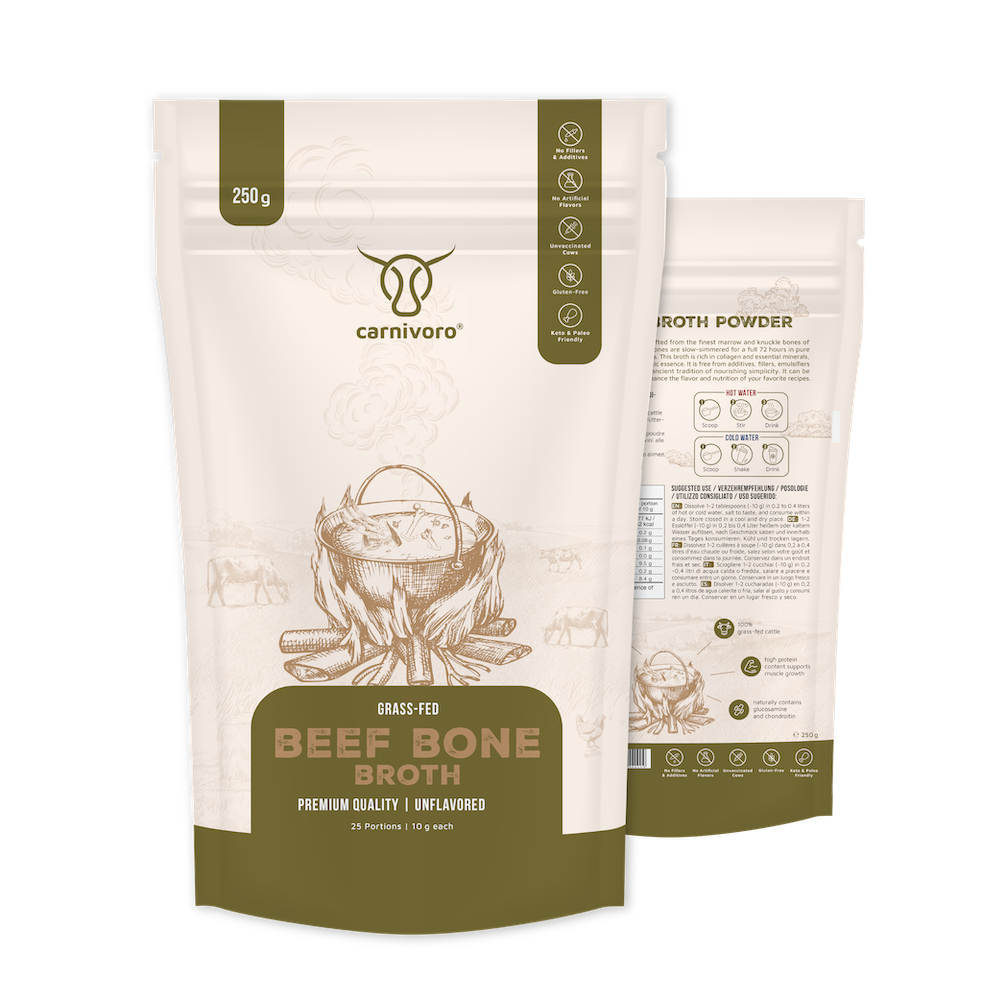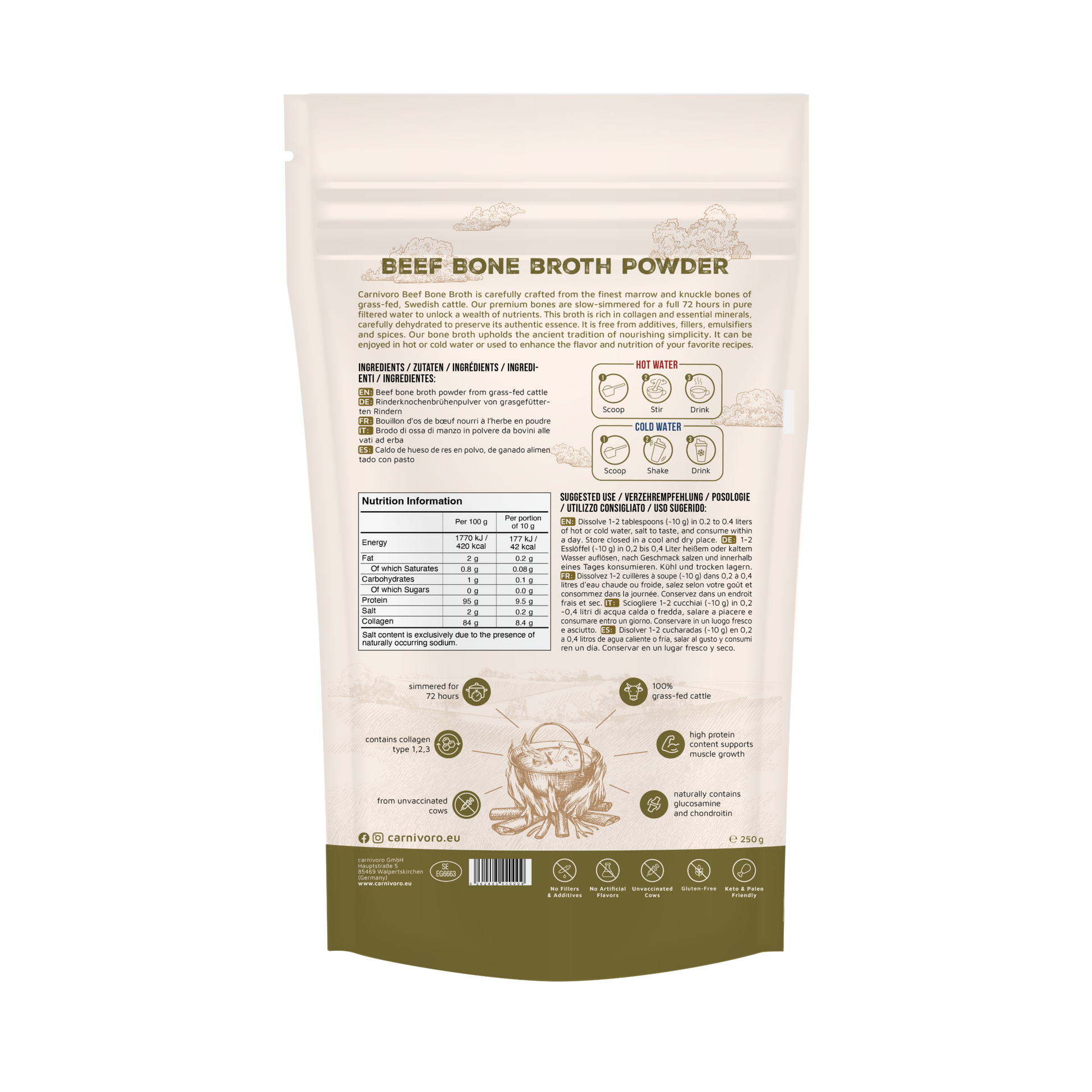Beef Bone Broth
Beef Bone Broth
carnivoro®
Beef Bone Broth
Beef Bone Broth
carnivoro®
100% grass-fed
Pasture-raised
Unvaccinated cattle
Nourishing primal power for your everyday life: Collagen, minerals & amino acids in their purest form
Strengthens, regenerates and soothes!
- For radiant skin, a healthy gut & strong joints
- To naturally strengthen vitality
- Contains collagen 1, 2 & 3
- with valuable amino acids, minerals & glycine
- From grass-fed Swedish beef
- NO emulsifiers such as soy or sunflower lecithin
- Laboratory tested for heavy metals
Couldn't load pickup availability
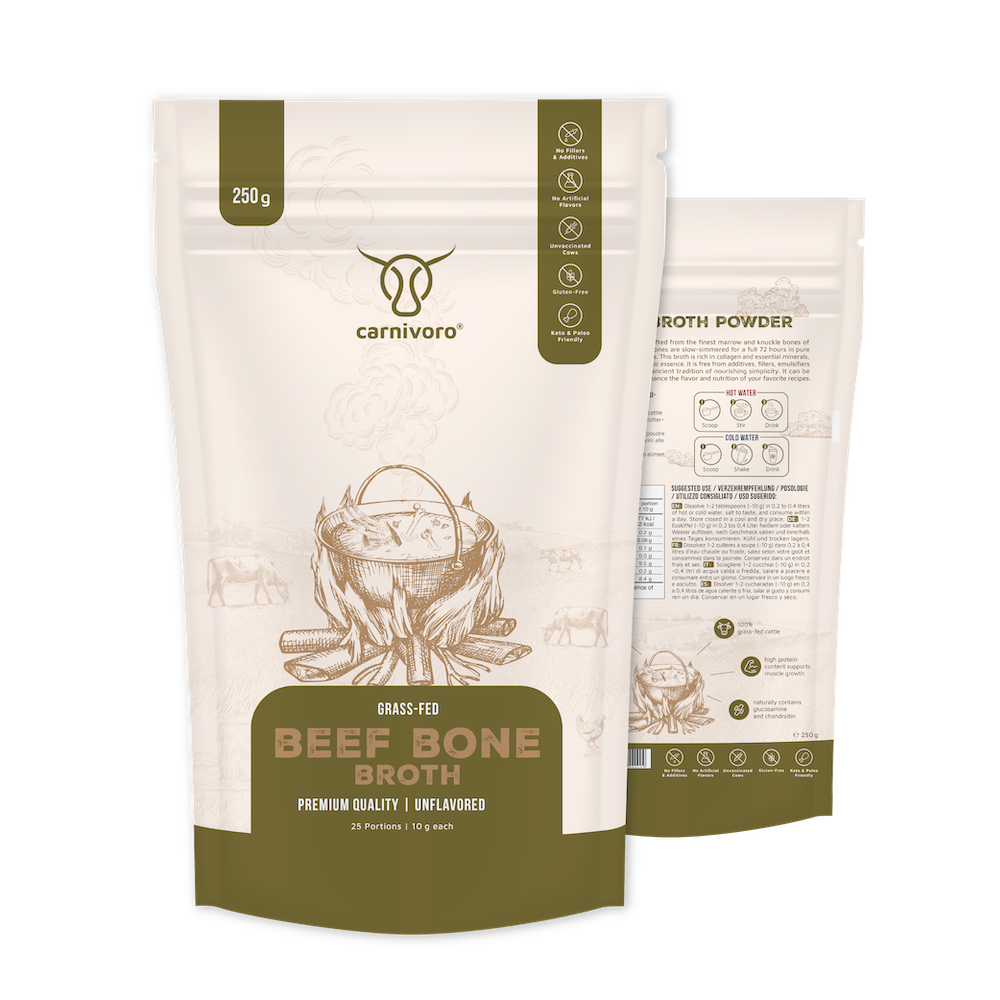


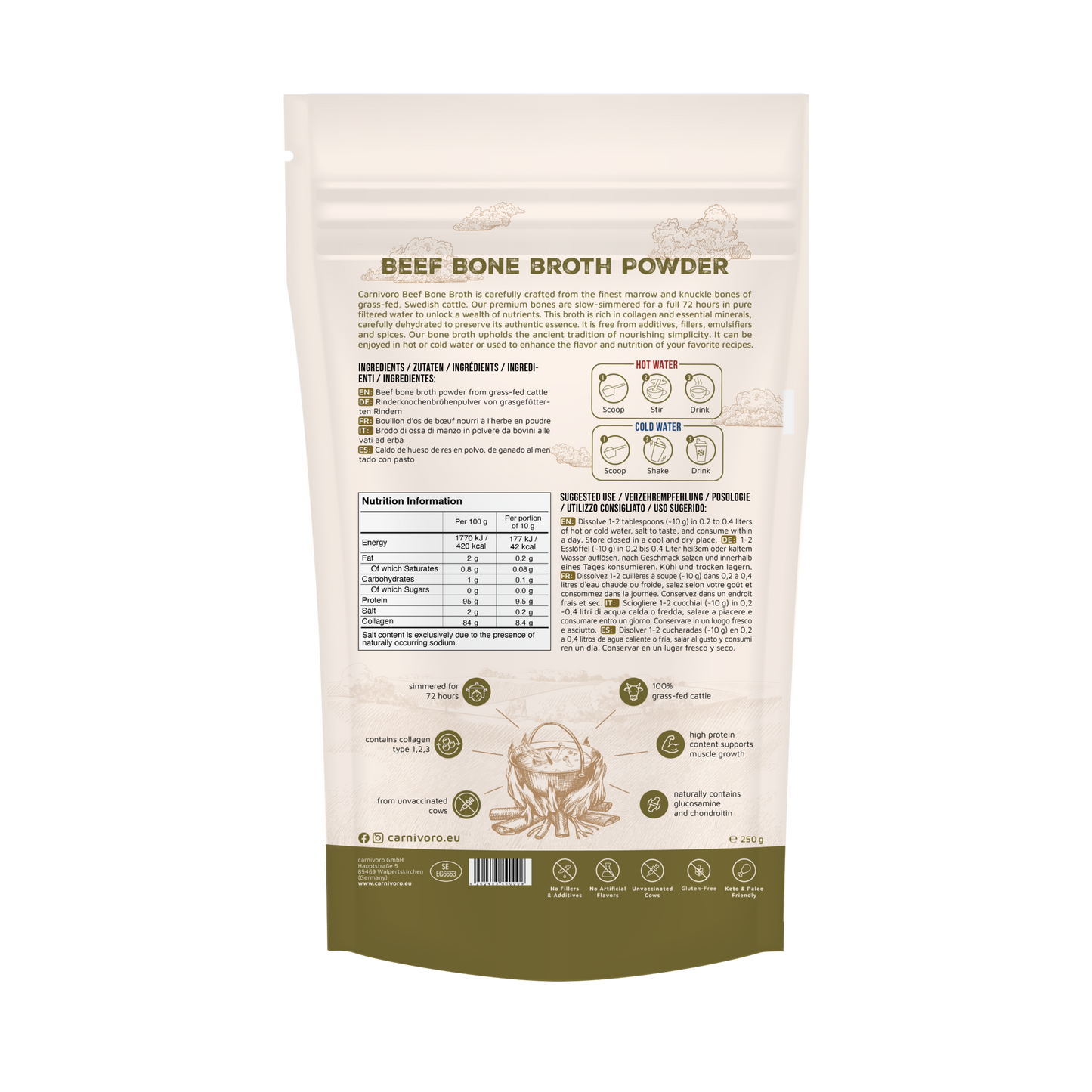
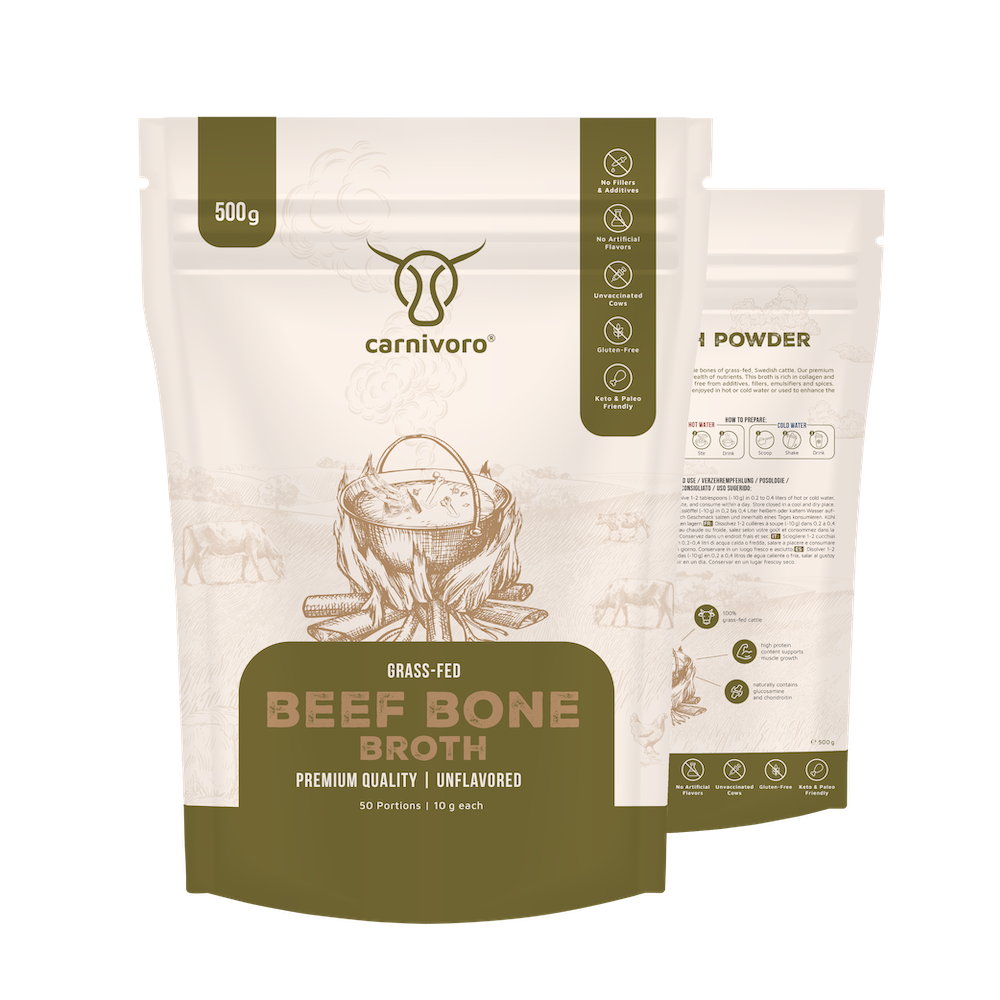
Collapsible content
Legal Notice
Storage: Store closed, cool, and dry.
*Health claims according to Regulation (EU) No. 432/2012
ingredients
Beef Bone Broth Powder
Shipping Information
3,99 €
Free shipping from 55,00 € (DE) from 150 € Europe-wide (EU)
contents
250g/500g
Consumption recommendation
Add 1-2 tablespoons of bone broth powder to an empty glass or cup and pour in 200 ml of hot water, stirring well.
We have been using this bone broth for a while now, adding to all our soups and stews etc. Not only is it packed with nutrients, it really makes a difference to the final dish, adding a richness and gloss, which we love. I like that it comes from grass fed unvaccinated cattle too
Wohltuend, heilend und geschmacklich top. Ich bestelle die Brühe regelmäßig!
Manchmal ist es gut, wenn es schnell geht. Diese Knochenbrühe ist eine wertvolle und gute Alternative, wenn ich nicht dazu gekommen bin meine Knochenbrühe selbst aufzusetzen oder wenn ich unterwegs bin. Mit einem Schuss Sojasoße trinke ich meine Brühe am Liebsten. Ich bin sehr dankbar, dass es dieses Produkt gibt. Schnell und einfach anzurühren.

When your body calls out loudly, but no one hears it…
Tired in the morning, even though you’ve slept enough. Irritated stomach, pale skin, joints that no longer move smoothly. And you have the feeling: You’re already doing everything for your health and fitness… but somehow something is missing.
The answer does not lie in more exotic superfood trends or synthetic supplements from the lab, but in a return to the wisdom of our ancestors.
Even Hippocrates, the father of Western medicine, recommended bone broth to strengthen digestion, constitution, and as a natural food that brings the body back into balance.
Meat and fish broths play a central role in all traditional cuisines worldwide, especially in French, Italian, Chinese, Japanese, African, South American, Middle Eastern, and Russian cuisines.
Bone broth has been used in traditional medicine for over 2,500 years to support digestion, as a blood builder, and to strengthen the kidneys.
Although bone broth has gained popularity in recent years, particularly through the Paleo movement, it is suitable for anyone looking to support their body with natural protein, minerals, and collagen building blocks or who is interested in anti-aging.
Imagine...
- a cup of hearty broth that warms you like a hug from the inside
- a sip that gives you concentrated nutrients with a boost you can feel immediately
- A simple routine in your busy life that truly strengthens your body without much effort
That's exactly what you get with carnivoro ® Beef Bone Broth
Our bone broth comes from Sweden, a country with particularly high standards in animal husbandry. The cattle are 100% grass-fed and organically certified.
The bones are simmered for 72 hours in filtered water to extract maximum collagen, minerals, and amino acids. The broth is then gently processed into powder - without soy, lecithins, preservatives, or emulsifiers.
Beef Bone Broth is the perfect Lösion for you if you …
- have no time (or desire) to cook bone broth for hours every day
- are looking for natural collagen sources to support skin, joints, and connective tissue
- you want to gently strengthen your gut (e.g. during fasting, exhaustion, or leaky gut)
- you are looking for a simple, warm nutrient source to go
- you want to support your body in regenerating naturally
Frequent Questions-FAQ
A “bone broth” is a clear, rich, and nutrient-dense broth made by slowly simmering animal bones — often with meat, vegetables, and spices.
The term “bone broth” comes from English, but the concept is well known across many cultures and traditions worldwide. To make bone broth, beef, chicken, pork, or fish bones are typically used. They are soaked in water and then simmered slowly over a long period — often 12 hours or more. During cooking, the bones, meat, connective tissue, tendons, and collagen break down and release nutrients, resulting in a rich, gelatinous consistency.
Bone broths are valued for their numerous potential health benefits. They are rich in minerals such as calcium, magnesium, and phosphorus, and contain gelatin, collagen, and amino acids believed to support healthy skin, hair, nails, and joints.
Many of our customers also drink bone broth to soothe the digestive tract, strengthen the immune system, and reduce inflammation.
Additionally, bone broth is often used as a base for soups, stews, sauces, and other dishes to enhance flavor and nutrition. While making bone broth requires time and patience, it remains a delicious and nutrient-rich addition to a balanced diet.
Here’s a simple recipe for beef bone broth you can make at home. Please note that the preparation time for bone broth is long.
Ingredients:
- 2–3 kg beef bones (marrow bones or bones with meat remnants)
- 2 onions, roughly chopped
- 3 carrots, roughly chopped
- 3 celery stalks, roughly chopped
- 4–5 garlic cloves, roughly chopped
- 2 tablespoons apple cider vinegar (helps release minerals from the bones)
- A handful of fresh herbs (e.g., parsley, thyme, rosemary)
- 1 teaspoon black peppercorns
- 2 bay leaves
- 4–5 liters of water
Instructions:
Preheat the oven to 220°C. Place the beef bones in a large roasting pan or on a baking sheet and roast them in the preheated oven for about 30 minutes. This enhances the flavor and browns the bones.
While the bones are roasting, prepare the vegetables by roughly chopping the onions, carrots, celery, and garlic.
Remove the roasted bones from the oven and place them in a large pot. Pour the vinegar over the bones and fill the pot with cold water until the bones are just covered.
Place the pot on the stove and bring the water to a boil. Then reduce the heat to a very low simmer. You don’t want the broth to boil too hard, as this can create cloudiness and destroy some of the nutrients.
Add the chopped vegetables, herbs, black peppercorns, and bay leaves. Let the broth simmer for at least 8–10 hours — the longer, the better. Many people even let it cook overnight.
During cooking, foam and impurities may appear on the surface. Skim these off occasionally to keep the broth clear.
Once the broth has simmered long enough, remove the pot from the heat and let it cool slightly. Strain out the bones and vegetables using a sieve to obtain a clear broth. You can season it further with salt and pepper to taste.
The finished bone broth can be enjoyed as a nourishing drink or used as a base for soups, stews, and other dishes.
If all of this seems too time-consuming or complicated, you can simply dissolve a spoonful of our bone broth powder in hot water in seconds.
That way, you can enjoy all the health benefits of traditional bone broth instantly — anytime, anywhere.
Add 1–2 tablespoons of bone broth powder to an empty glass or cup, pour 200 ml of hot water over it, stir well (to avoid clumping), and season to taste.
Then add bone marrow (beef bone marrow fat) or 100% beef kidney fat, and in just 2 minutes you’ll have an incredibly nutritious, homemade soup.
Another way to use premium bone broth powder is to sprinkle it over your meals like a seasoning. Or use it instead of protein powder in shakes, pancakes, or waffle recipes.
It is recommended to stir the powder into hot water using a milk frother, or use a protein shaker to mix your bone broth in seconds.
Bone broth often doesn't taste like a classic soup, because its preparation, composition, and purpose are completely different:
1. It doesn’t contain typical soup ingredients
Traditional soups contain ingredients such as:
- Carrots, celery, leeks
- Parsley, pepper, nutmeg
Our bone broth, on the other hand, consists only of bones and water. It contains no vegetables, no spices, no salt — meaning less umami, less sweetness, and less depth of flavor.
2. The long cooking process creates different aromas
Our bone broth is simmered for over 72 hours to extract as much collagen, minerals, and gelatin as possible from the bones.
This results in mild, almost neutral-mineral flavor notes that have little in common with the typical 'soup taste.'
3. The focus is on nutrients, not flavor
Our bone broth is more of a functional drink, consumed for its effects on joints, skin, gut, and the immune system, rather than for its taste. Many even drink it plain or with just a pinch of salt.
4. Missing fat & roasted aromas
If the bones were not roasted beforehand, the typical roasted, meaty aroma is missing. The fat is also often skimmed off, which makes the broth taste rather flat.
Tip:
Simply add some salt, spices, and fat, and you’ll have an extremely nourishing soup.

More regeneration. More vitality. More you. Feel good in your skin.
Why collagen is so valuable
The carnivoro ® Beef Bone Broth is rich in collagen (84%). Collagen is the most abundant protein in the human body and is essential for skin, bones, tendons, and joints¹.
However, starting from the age of 25, the body's own collagen production decreases significantly². Nowadays, the average person consumes very little collagen through food, which is why it is so important to supplement collagen to maintain normal bones and muscles as we age.
Studies also show that targeted collagen supplementation can have positive effects on joint health³, skin elasticity⁴, and muscle strength⁵.
Glycine - the versatile helper for body and mind
Beef Bone Broth contains plenty of glycine, a non-essential amino acid that plays a key role in many bodily functions.
Glycine supports the body's own collagen production⁶, has anti-inflammatory effects⁷, and contributes to strengthening the immune system⁸.
Furthermore, glycine promotes liver function by participating in detoxification⁹ and can improve sleep quality as it has a calming effect on the central nervous system¹⁰.
Glycine also plays an important role in tissue regeneration and supporting a healthy gut barrier¹¹.
Especially among our customers who struggle with gut issues or leaky gut, Beef Bone Broth is therefore a very popular supplement.
Minerals and amino acids - the complete package for your health
Bone broth also provides important minerals such as calcium, magnesium, potassium, and phosphorus: essential for bone strength, nerve function, and electrolyte balance¹². Additionally, it contains valuable amino acids like proline, glutamine, and arginine:
- Proline supports the formation of collagen and has antioxidant effects¹³.
- Glutamine strengthens the intestinal mucosa and is an energy source for intestinal cells¹⁴.
- Arginine improves blood circulation, supports wound healing, and can modulate the immune system¹⁵.
Gelatin - Natural support for your digestion
Gelatin, which is produced by slowly cooking bones, is a protein derived from collagen. It supports the health of the gastrointestinal tract by soothing the intestinal mucosa and promoting the regeneration of the mucosa¹⁶. Additionally, gelatin improves digestion and helps optimize nutrient absorption¹⁷. Furthermore, anti-inflammatory effects in the digestive system can contribute to relief¹⁸.
Bone Broth Powder is an investment in your long-term health and performance.
If you want to support your body naturally, seek noticeable changes, and value quality, you will find a high-quality source here that makes exactly that possible.
Your benefits with Beef Bone Broth at a glance:
- Supports joint health through high-quality collagen.
- Promotes healthy skin, hair, and nails.
- Provides essential minerals such as calcium, magnesium, and phosphorus.
- Strengthens the immune system with valuable amino acids.
- Supports healthy digestion with soothing gelatin.
- Has anti-inflammatory effects.
- Delivers natural nutrients for holistic support of your body.
References:
¹ Ricard-Blum, S. (2011). The collagen family. Cold Spring Harbor Perspectives in Biology.
² Proksch, E. et al. (2014). Skin aging and collagen loss. Dermatology Research and Practice.
³ Clark, K. L. et al. (2008). 24-week study on the use of collagen hydrolysate as a dietary supplement in athletes with activity-related joint pain. Current Medical Research and Opinion.
⁴ Proksch, E. et al. (2014). Oral supplementation of specific collagen peptides has beneficial effects on human skin physiology: a double-blind, placebo-controlled study. Skin Pharmacology and Physiology.
⁵ Zdzieblik, D. et al. (2015). Collagen peptide supplementation in combination with resistance training improves body composition and increases muscle strength in elderly sarcopenic men. British Journal of Nutrition.
⁶ Wu, G. et al. (2011). Collagen synthesis and glycine. Amino Acids.
⁷ Zhong, Z. et al. (2003). Glycine inhibits inflammatory cytokine expression by modulation of NF-κB signaling. Shock.
⁸ Razak, M. A. et al. (2017). Multifunctional role of glycine in health and disease. Frontiers in Molecular Biosciences.
⁹ McCarty, M. F. et al. (2000). Glycine may serve as a hepatoprotective agent. Medical Hypotheses.
¹⁰ Bannai, M. et al. (2012). The effects of glycine on subjective daytime performance in partially sleep-deprived healthy volunteers. Frontiers in Neurology.
¹¹ Lobo, D. N. (2004). Glycine and gut barrier function. Clinical Nutrition.
¹² Maughan, R. J. et al. (2004). Electrolyte and mineral balance in physically active individuals. Nutrition.
¹³ Kivirikko, K. I. et al. (1998). Proline and collagen biosynthesis. International Journal of Biochemistry & Cell Biology.
¹⁴ Wischmeyer, P. E. (2006). Glutamine and gut integrity. Current Opinion in Clinical Nutrition and Metabolic Care.
¹⁵ Wu, G. et al. (2009). Arginine metabolism and nutrition in growth, health and disease. Amino Acids.
¹⁶ Lien, K. et al. (2017). Gelatin and gut health: a review. Food & Function.
¹⁷Wang, J. et al. (2018). Effects of gelatin on nutrient absorption and gut barrier function. Journal of Nutritional Biochemistry. ¹⁸ Wu, G. et al. (2010). Anti-inflammatory properties of gelatin-derived peptides. Nutrients.

